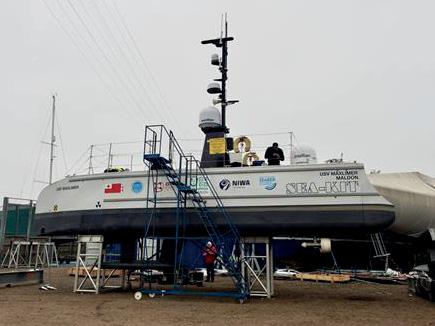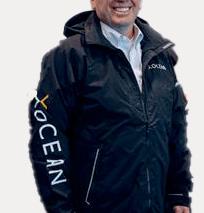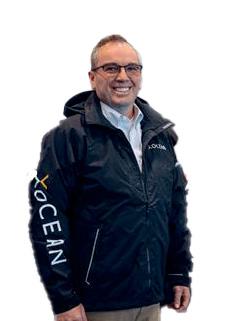
3 minute read
Into the void
SEA-KIT USV EMBARKS TO MAP TONGA VOLCANO
The recent Tongan volcanic eruption will be investigated by UK uncrewed surface vessel Maxlimer
An uncrewed surface vessel (USV) is about to leave for Tonga, where it will embark on a voyage to the caldera of the Hunga Tonga-Hunga Ha’apai (HT-HH) undersea volcano that erupted on January 15.
From the surface of the Pacific Ocean, the UK firm Sea-Kit International’s USV Maxlimer will collect data from inside the volcano mouth - the caldera - where it will remain for about a month.
The data collection is part of a project by the Nippon Foundation and NIWA (New Zealand’s National Institute of Water and Atmospheric Research) to look at the undersea impacts of the Tongan eruption.
The HT-HH eruption was considered remarkable because of the height of its plume, whose umbrella clouds reached 31km, according to the ESSOAr, the Earth and Space Science Open Archive.
The volcano erupted over a couple of weeks, with the final explosion on January 15 obliterating the island.
Now NIWA scientists are sailing to Tonga to survey thousands of square kilometres of the seabed around the area, collecting video images of the impact, using NIWA’s research vessel Tangaroa and Maxlimer.
The ’Tonga Eruption Seabed Mapping Project’, or TESMaP, is funded by the Nippon Foundation, which has been enabling oceanic projects since 1962.
It is currently leading a Seabed 2030 project, which intends to map the world’s entire seabed by 2030.
Project leader and NIWA Chief Scientist Oceans Mike Williams said he expected extensive changes to the underwater landscape in the area.
“Before the eruption, much of the volcano was above water but now none of it is and the neighbouring islands of Hunga Tonga and Hunga Ha’apai were reduced in size,” he said. ”We expect similarly dramatic changes to have occurred in the underwater topography.
“Submarine cable breakages show impacts up to 50 kilometres from the volcano caldera, implying changes to the seabed over an area of at least 8,000 square kilometres. This survey will investigate the impacts of the eruption in the water column and on the seabed around HT–HH.”
Acoustic data will be gathered using echosounders to determine the shape and structure of the underwater landscape, including the thickness of ash deposits and the formation of any new bedforms.
This data will then be compared with previous maps to identify areas for sampling, so that further changes to the area, such as impacts to marine life and the seafloor’s chemical composition, can be assessed.
ared with previous maps to that further changes to the rine life and the seafloor’s ssessed.
8 SEA-KIT USV
Maxlimer preparing for despatch to Tonga
rXOCEAN appoints chief technology offi cer

XOCEAN has appointed a new chief technology offi cer in the latest expansion of its leadership team.
Shepard (Shep) Smith’s background is in hydrographic survey and new technology implementation, having served 28 years as a commissioned officer with NOAA, rising to the rank of Rear Admiral.
Chief executive James Ives welcomed Smith to the XOCEAN team. “Throughout Shep’s career, he has continually pushed the boundaries of ocean technology, and we’re really excited to have him leading the next phase of our technical journey,” he said.
“Above all, we share the same vision of transforming ocean data through technology with the purpose of supporting the sustainable growth of the ocean economy.”
Smith will be responsible for developing XOCEAN’s technology roadmap, advancing the boundaries of uncrewed surface vessel technology and driving the technical vision for the business.
In 2019, XOCEAN bought hydrographic survey firm 4D Ocean to expand its subsea services.
XOCEAN uses its in-house marine robotic technology to collect ocean data sustainably across a range of industries, including offshore wind. The company is headquartered in Ireland, with offices in the UK, Canada, Norway and most recently the US.

8 Shep Smith, Shep Smith,






